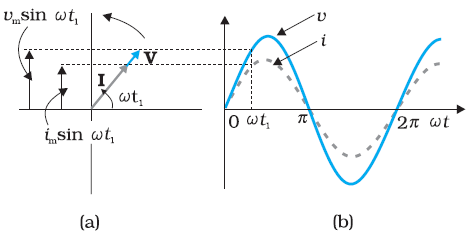Diagram
Phasor Diagram for a resistive circuit

Formula
Current through a resistor when AC voltage is applied
where is the amplitude of the oscillating potential and is the angular frequency
Definition
Inductive reactance
The opposition to current flow through an inductor is proportional to both the amount of inductance and to the frequency of the current in the inductor. This opposition to current flow is called INDUCTIVE REACTANCE . It is written as
where is inductive reactance, is the angular frequency and L is the inductance.
where is inductive reactance, is the angular frequency and L is the inductance.
Diagram
Phasor Diagram for a inductive circuit

Formula
Instantaneous and average power for an inductive circuit
The instantaneous power supplied to the inductor is
The average power supplied to an inductor over one complete cycle is zero since average of over a complete cycle is zero.
The average power supplied to an inductor over one complete cycle is zero since average of over a complete cycle is zero.
Definition
Explain the magnetisation and demagnetisation of an inductor on application of AC

1. 0-1: ENERGY IS ABSORBED FROM THE SOURCE.
2. 1-2: ENERGY IS BEING RETURNED TO SOURCE.
3. 2-3: ENERGY IS ABSORBED.
4. 3-4: ENERGY ABSORBED DURING THE CYCLE 2-3 IS RETURNED TO THE SOURCE.
2. 1-2: ENERGY IS BEING RETURNED TO SOURCE.
3. 2-3: ENERGY IS ABSORBED.
4. 3-4: ENERGY ABSORBED DURING THE CYCLE 2-3 IS RETURNED TO THE SOURCE.
Formula
Current through a inductor when AC voltage is applied
where is the current through the inductor,
is the amplitude of the current, where is the angular frequency and is the inductance.
Definition
Capacitive reactance
Capacitive reactance is an opposition to the change of voltage across a capacitance. It is written as
,
where is capacitive reactance, is angular frequency and C is the capacitance.
,
where is capacitive reactance, is angular frequency and C is the capacitance.
Diagram
Phasor Diagram for a capacitive circuit

Formula
Instantaneous and average power for an capacitive circuit
The instantaneous power supplied to the capacitor is
The average power is since is zero over a complete cycle.
The average power is since is zero over a complete cycle.
| BookMarks |
0 Comments
Post a Comment